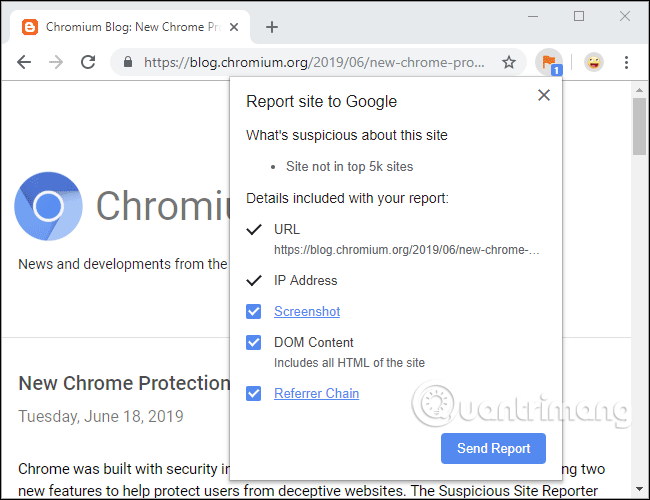How to report phishing and malicious websites in Google Chrome
Now you can easily report suspicious websites in Chrome. You should report the site if it is phishing, malware or similar hosting site. Google will use that report to block websites for everyone.
- What to do if Google Chrome warns an unsafe website?
- Check the safety of links, web pages
- 7 ways to protect your web browser from network attacks
This official new browser extension reports bad websites for Google Safe Browsing. This is a service that web browsers like Google Chrome, Apple Safari and Mozilla Firefox use to actively block malicious websites. When accessing a website, the browser checks to see if it matches the list of bad websites and gives warnings if found. You can view this as antivirus software with other definitions only that it blocks bad websites.
Previously, you could report malicious websites by visiting Google's Report Phishing Page page and entering the website address. You can still do the above but now with Chrome extension, this process will be much easier.
To use this extension, install Suspicious Site Reporter from the Chrome Web Store. After installing it, you can click on the flag icon on the toolbar to report the bad website.
- Download Suspicious Site Reporter
 How to report phishing and malicious websites in Google Chrome Picture 1
How to report phishing and malicious websites in Google Chrome Picture 1
This extension will allow you to choose to share web site screenshots, DOM content (all HTML of the website) and how you handle that suspicious site. However, your website URL and IP address are required.
Google can use reports from Chrome users to actively block suspicious sites so people don't access that page anymore.
The company released this Chrome extension on June 18, 2019. This feature goes hand in hand with other improvements against scams on Chrome, including warnings about cryptic URLs like go0ogle.com in Chrome 75.
You should read it
- How to report suspicious Android applications
- How to use ThreatSlayer to block malicious websites on Chrome
- Why can GDPR warn of malicious websites?
- High security but iPhone can still be hacked when accessing malicious websites
- What is pastejacking? How to protect your computer from Pastejacking?
- How to enable redirection blocking to malicious websites on Google Chrome
- Detecting a Chrome extension infected with malicious code, stealing the password and the user's e-wallet key
- How to create a free website with Google Sites
- A series of WordPress websites are hacked
- A malicious extension 'occupies' Chrome and Firefox browsers appears, preventing users from uninstalling
- Google: Play Protect helped cut 20% of malicious Android application installations by 2018
- Pornographic websites are 'malicious code'






 How to enable redirection blocking to malicious websites on Google Chrome
How to enable redirection blocking to malicious websites on Google Chrome How to use ThreatSlayer to block malicious websites on Chrome
How to use ThreatSlayer to block malicious websites on Chrome 28 dangerous extensions you should immediately remove from Chrome and Microsoft Edge
28 dangerous extensions you should immediately remove from Chrome and Microsoft Edge How to report phishing emails in Outlook.com
How to report phishing emails in Outlook.com Microsoft put Windows Defender add-on on Google Chrome
Microsoft put Windows Defender add-on on Google Chrome New Android Trojans lead users to phishing websites by notification on the application
New Android Trojans lead users to phishing websites by notification on the application